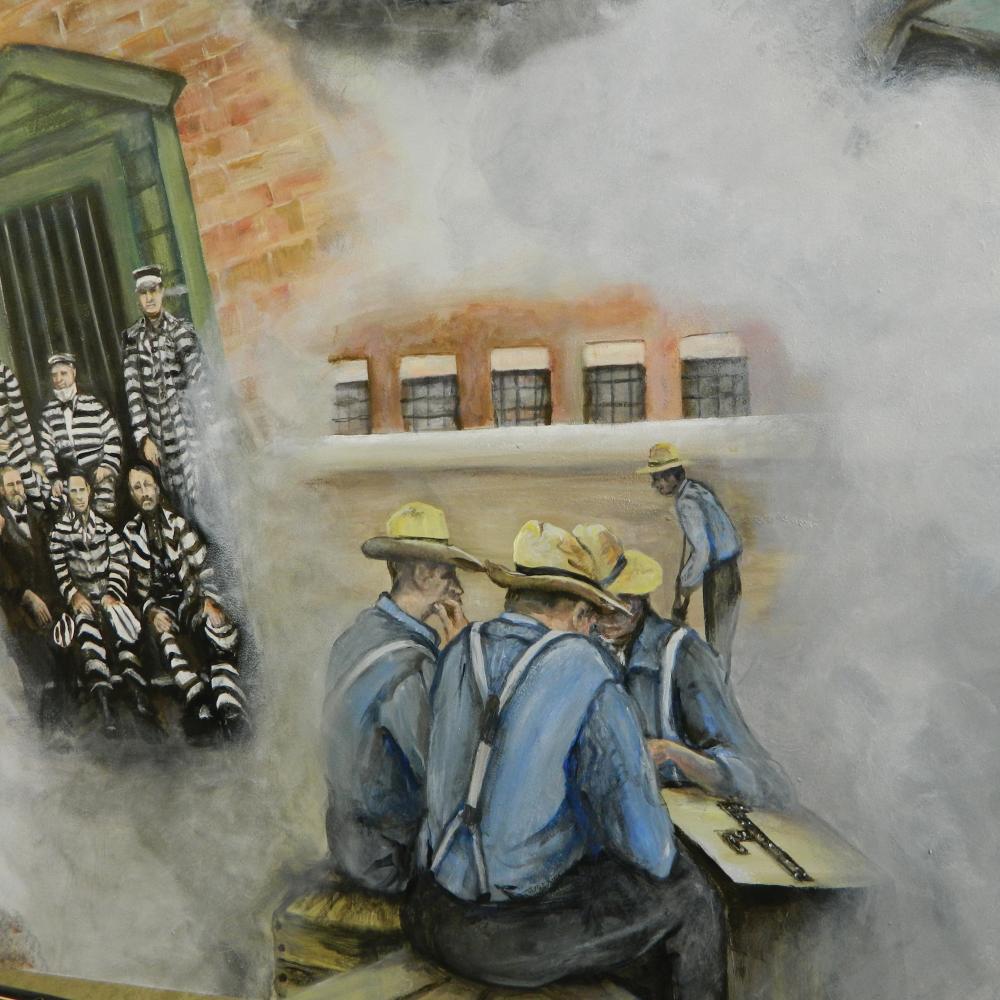Early in the morning, a train roars past Armory Arts Village—a resident artists’ community in Jackson. Although the train passes less than a mile away, inside the armory you can hear only a muffled whistle. The walls are lined with three feet of woven steel, so very little sound seeps in.
The walls attest to the building’s origins as a state prison, as do the barred windows, the three remaining guard turrets, and the sprawling, brightly colored murals that greet visitors coming to see both what the prison was and what it has become.
The eight murals hang in Armory Arts’ West Hall, depicting the prison’s evolution from a cluster of wooden buildings and a tamarack-pole fence in 1839 to a virtual city-within-a-city that transformed Jackson into an industrial powerhouse in the early twentieth century.
Resident artists Jean Weir and Hector Trujillo painted the murals with support from a Michigan Humanities grant. Resident and founder and owner of Jackson Historic Prison Tours, Judy Gail Krasnow, served as historical director of the project.
“The murals make a big statement,” Weir says. “We took all this information and tried to document it and now there’s a visual record of it, here in its home.”
The painters drew directly from historical photographs, working from as many as twenty images for each vignette that wasn’t directly copied. The smaller murals include depictions of a wagonload of prisoners arriving at the original wooden structure, a chain gang laboring in a field under the watchful eye of a guard, and the prison baseball team posing for a group portrait. The largest of these composite images, eighteen-feet in length, depicts the prison during its heyday. The beautiful administrative building—designed by Elijah E. Myers, the same architect responsible for three state capitols—spreads behind a verdant lawn where townspeople gathered to hear the prison band. Smokestacks from the factories housed within the prison’s walls loom in the background.
Honestly presenting the prison’s history is a challenge for those involved in telling its story, as accounts of violence and cruelty intermingle with humorous and heartwarming anecdotes.
The prison’s baseball team consistently defeated big-name teams brought to play them. The talent of the prison’s tailors, all inmates, was so renowned that women brought their daughters from Ann Arbor to have their wedding dresses made.
One inmate, named Hannibal “the Bear,” taught himself to knit, so he could make a scarf for the watchman he considered a friend. Another, only known as “The Crow,” waited until his fellow prisoners fell asleep before waking them with incredibly loud crow calls. The identity of The Crow was never revealed as the prison echoed too loudly for guards to discover where the caws originated.
The story of “The Crow” takes a darker turn when one realizes that prisoners were often brutally punished for breaking the prison’s rules of silence. At one point, the standard punishment for such offenders was tying them by the hands and hanging them from a hook in the ceiling, so their feet were five inches off the ground. They could be left there for as long as twelve hours.
“An old historic building can’t escape its history,” Krasnow says. “But history continues.”
The artists of Armory Arts are endeavoring to brighten the building’s future without forgetting its past. Every apartment retains some of the original architectural elements of the prison, ranging from iron bars on the windows to exposed brick walls with cell numbers still painted on.
In a studio, where the size of the cramped cells is apparent from arches in the ceiling, one resident teaches affordable art classes to local children and adults hoping to tap into long-neglected talents. When a ceramicist moved into a corner apartment left with particularly jagged brickwork along one wall, she used the broken and uneven bricks to display small pottery items.
By increasing awareness of the prison’s history, Krasnow hopes to remove some of the shame in Jackson’s roots as “a prison town” and shed some light on the contributions of the inmates.
The murals help in this endeavor, providing on-site visuals for Krasnow’s tours as well as any passersby who wander in out of curiosity—many of whom are Jackson residents with a personal connection to the prison, interested in seeing what role Armory Arts is going to play in their city’s future.


